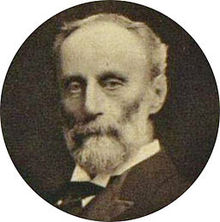Charles Wood, 2nd Viscount Halifax
The Viscount Halifax | |
|---|---|
 Halifax in 1914 | |
| Personal details | |
| Born | Charles Lindley Wood 7 June 1839 London, England |
| Died | 19 January 1934 (aged 95) Hickleton Hall, Doncaster, England |
| Resting place | Hickleton Hall, Doncaster, England |
| Spouse | Lady Agnes Courtenay |
| Children | 6, including Edward Wood, 1st Earl of Halifax |
| Parent(s) | Charles Wood, 1st Viscount Halifax Lady Mary Grey |
| Education | Eton College |
| Alma mater | Christ Church, Oxford |
Charles Lindley Wood, 2nd Viscount Halifax (7 June 1839 – 19 January 1934) was a British ecumenist who served as president of the English Church Union from 1868 to 1919, and from 1927 to 1934.
Early life and education
Halifax was born in London; the eldest son of Charles Wood, 1st Viscount Halifax, a prominent Whig politician, and Lady Mary, the fifth daughter of Charles Grey, 2nd Earl Grey. As a student at Eton he was the favourite of William Johnson Cory, his Master, who dedicated his book of Uranian verse, Ionica, to him. Between 1858 and 1863, he studied law and modern history at Christ Church, Oxford.
English Church Union
An Anglo-Catholic, Halifax became influenced by the Oxford Movement, and at the request of Edward Bouverie Pusey, became president of the English Church Union, a society dedicated to the promotion of Catholic principles and practices within the Church of England, in 1868. Along with the Abbé Ferdinand Portal he played a prominent role in the attempt to bring about dialogue between the Roman Catholic Church and the Church of England on the subject of Anglican Orders. Owing to what can only be viewed as a form of obstructionism between Canterbury and Westminster, no constructive dialogue ever came about, however, and the unhoped for result of Halifax's actions was the condemnation of Anglican Orders as "absolutely null and utterly void" in the Papal Encyclical Apostolicae curae. The Archbishop of Canterbury Edward White Benson and the Archbishop of Westminster, Cardinal Herbert Vaughan, can be accused of letting this early attempt at reapproachment fall away due to the narrow-minded vision of each other's place in the English Church during that era. It might also be argued that Pope Leo XIII was led astray by Vaughan and like-minded Roman Catholic scholars who viewed the Church of England as a state church with no real theological authority. Benson, like most Anglican clergy in the power structure viewed any Roman Catholic involvement in England as the "Italian Mission", with not even a toehold worth acknowledging in English Society.
Halifax served as president of the English Church Union until 1919, and again from 1927 until his death. One of his last achievements was the union of the English Church Union with the Anglo-Catholic Congress in 1933.
Personal life

Halifax was a collector of ghost stories, many of which are to be found in Lord Halifax's Complete Ghost Book (ISBN 1-55521-123-2) and The Ghost Book of Charles Lindley, Viscount Halifax (ISBN 978-0-7867-0151-3).
Halifax married Lady Agnes Elizabeth Courtenay (1838–1919), daughter of William Courtenay, 11th Earl of Devon, and his wife, Lady Elizabeth Fortescue, daughter of Hugh Fortescue, 1st Earl Fortescue. They had four sons and two daughters:[1]
- Hon. Charles Reginald Lindley Wood (17 July 1870 – 6 September 1890)[2][roberts 1][3]
- Hon. Alexandra Mary Elizabeth Wood (25 August 1871 – 10 March 1965)
- Hon. Francis Hugh Lindley Wood (21 September 1873 – 17 March 1889)[4][roberts 2][3]
- Hon. Mary Agnes Emily Wood (25 March 1877 – 25 March 1962), married in 1903 George Lane-Fox, 1st Baron Bingley
- Hon. Henry Paul Lindley Wood (25 January 1879 – 6 June 1886)
- Edward Frederick Lindley Wood, 3rd Viscount Halifax and 1st Earl of Halifax (16 April 1881 – 23 December 1959)
Halifax died in 1934 aged 94, having outlived his three eldest sons. His fourth and youngest son succeeded to the viscountcy and was created Earl of Halifax in 1944 after serving as Viceroy of India, Secretary of State for Foreign Affairs and British Ambassador to the United States.
Notes
- ^ The website The Peerage, entry for 2nd Viscount Halifax gives his date of death as 6 September 1899. Andrew Roberts gives the date of his death as 1890, quoting a letter from Halifax to his son Edward in 1893 stating that he was his "only son left".
- ^ Andrew Roberts gives the date of his death as 1888.
References
- Cobb, Peter G. (October 2008). "Wood, Charles Lindley, second Viscount Halifax (1839–1934)". Oxford Dictionary of National Biography. Oxford University Press. doi:10.1093/ref:odnb/36997. Retrieved 2009-06-21. (subscription or UK public library membership required)
- Burke’s Peerage 1963 Edition, Vol I (A-L)
- Andrew Roberts, The Holy Fox: The Life of Lord Halifax (Phoenix, 1997 (originally published 1991))(a biography of the 3rd Viscount Halifax).
